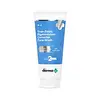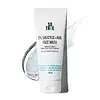What's inside
What's inside
 Key Ingredients
Key Ingredients

 Benefits
Benefits

 Concerns
Concerns

 Ingredients Side-by-side
Ingredients Side-by-side

Water
Skin ConditioningAcrylates Copolymer
Sodium Lauroyl Sarcosinate
CleansingPropanediol
SolventCocamidopropyl Betaine
CleansingSodium Cocoamphoacetate
CleansingNiacinamide
SmoothingPolyglycerin-3
HumectantSodium Methyl Oleoyl Taurate
CleansingXylitol
HumectantGlucose
HumectantAnhydroxylitol
HumectantPhoenix Dactylifera Seed Extract
MoisturisingTranexamic Acid
AstringentAzelaic Acid
BufferingSodium Cocoyl Apple Amino Acids
Skin ConditioningSodium Hydroxide
BufferingSaccharide Isomerate
HumectantCitric Acid
BufferingSodium Citrate
BufferingPhenoxyethanol
PreservativeEthylhexylglycerin
Skin ConditioningGlycolipids
Skin ConditioningPanthenol
Skin ConditioningSodium PCA
HumectantBetaine
HumectantBenzophenone-4
UV AbsorberSodium Gluconate
Skin ConditioningSoyethyl Morpholinium Ethosulfate
Lactic Acid
BufferingGlycolic Acid
BufferingWater, Acrylates Copolymer, Sodium Lauroyl Sarcosinate, Propanediol, Cocamidopropyl Betaine, Sodium Cocoamphoacetate, Niacinamide, Polyglycerin-3, Sodium Methyl Oleoyl Taurate, Xylitol, Glucose, Anhydroxylitol, Phoenix Dactylifera Seed Extract, Tranexamic Acid, Azelaic Acid, Sodium Cocoyl Apple Amino Acids, Sodium Hydroxide, Saccharide Isomerate, Citric Acid, Sodium Citrate, Phenoxyethanol, Ethylhexylglycerin, Glycolipids, Panthenol, Sodium PCA, Betaine, Benzophenone-4, Sodium Gluconate, Soyethyl Morpholinium Ethosulfate, Lactic Acid, Glycolic Acid
Water
Skin ConditioningGlycerin
HumectantPropylene Glycol
HumectantCocamidopropyl Betaine
CleansingSodium Lauroyl Methyl Isethionate
CleansingCoco-Glucoside
CleansingAloe Barbadensis Leaf Extract
EmollientSalicylic Acid
MaskingCitrus Limon Fruit Extract
MaskingCitrus Sinensis Peel Extract
PerfumingSodium PCA
HumectantZinc PCA
HumectantPanthenol
Skin ConditioningAllantoin
Skin ConditioningEthylhexylglycerin
Skin ConditioningPhenoxyethanol
PreservativeLactic Acid
BufferingSodium Gluconate
Skin ConditioningWater, Glycerin, Propylene Glycol, Cocamidopropyl Betaine, Sodium Lauroyl Methyl Isethionate, Coco-Glucoside, Aloe Barbadensis Leaf Extract, Salicylic Acid, Citrus Limon Fruit Extract, Citrus Sinensis Peel Extract, Sodium PCA, Zinc PCA, Panthenol, Allantoin, Ethylhexylglycerin, Phenoxyethanol, Lactic Acid, Sodium Gluconate
Ingredients Explained
These ingredients are found in both products.
Ingredients higher up in an ingredient list are typically present in a larger amount.
Cocamidopropyl Betaine is a fatty acid created by mixing similar compounds in coconut oil and dimethylaminopropylamine, a compound with two amino groups.
This ingredient is a surfactant and cleanser. It helps gather the dirt, pollutants, and other impurities in your skin to be washed away. It also helps thicken a product and make the texture more creamy.
Being created from coconut oil means Cocamidopropyl Betaine is hydrating for the skin.
While Cocamidopropyl Betaine was believed to be an allergen, a study from 2012 disproved this. It found two compounds in unpure Cocamidopropyl Betaine to be the irritants: aminoamide and 3-dimethylaminopropylamine. High-grade and pure Cocamidopropyl Betaine did not induce allergic reactions during this study.
Learn more about Cocamidopropyl BetaineEthylhexylglycerin (we can't pronounce this either) is commonly used as a preservative and skin softener. It is derived from glyceryl.
You might see Ethylhexylglycerin often paired with other preservatives such as phenoxyethanol. Ethylhexylglycerin has been found to increase the effectiveness of these other preservatives.
Lactic Acid is another well-loved alpha hydroxy acid (AHA). It is gentler than glycolic acid but still highly effective.
Its main role is to exfoliate the surface of the skin by loosening the “glue” that holds dead skin cells together. Shedding those old cells leads to smoother, softer, and more even-toned skin.
Because lactic acid molecules are larger than glycolic acid, they don’t penetrate as deeply. This means they’re less likely to sting or irritate, making it a great choice for beginners or those with sensitive skin.
Like glycolic acid, it can:
Lactic acid also acts as a humectant (like hyaluronic acid). It can draw water into the skin to improve hydration and also plays a role in the skin's natural moisturizing factor (NMF) in the form of sodium lactate.
Studies show it can boost ceramide production to strengthen the skin barrier and even help balance the skin’s microbiome.
To get results, choose products with a pH between 3-4.
Lower strengths (5-12%) focus on surface exfoliation; higher strengths (12% and up) can reach deeper in the dermis (deeper, supportive layer) to improve skin texture and firmness over time.
Though it was originally derived from milk, most modern lactic acid used in skincare is vegan. It is made through non-dairy fermentation to create a bio-identical and stable form suitable for all formulations.
When lactic acid shows up near the end of an ingredient list, it usually means the brand added just a tiny amount to adjust the product’s pH.
Legend has it that Cleopatra used to bathe in sour milk to help reduce wrinkles.
Lactic acid is truly a gentle multitasker: it exfoliates, hydrates, strengthens, and brightens. It's a great ingredient for giving your skin a smooth, glowing, and healthy look without the harshness of stronger acids.
Read more about some other popular AHA's here:
Learn more about Lactic AcidPanthenol is a common ingredient that helps hydrate and soothe the skin. It is found naturally in our skin and hair.
There are two forms of panthenol: D and L.
D-panthenol is also known as dexpanthenol. Most cosmetics use dexpanthenol or a mixture of D and L-panthenol.
Panthenol is famous due to its ability to go deeper into the skin's layers. Using this ingredient has numerous pros (and no cons):
Like hyaluronic acid, panthenol is a humectant. Humectants are able to bind and hold large amounts of water to keep skin hydrated.
This ingredient works well for wound healing. It works by increasing tissue in the wound and helps close open wounds.
Once oxidized, panthenol converts to pantothenic acid. Panthothenic acid is found in all living cells.
This ingredient is also referred to as pro-vitamin B5.
Learn more about PanthenolPhenoxyethanol is a preservative that has germicide, antimicrobial, and aromatic properties. Studies show that phenoxyethanol can prevent microbial growth. By itself, it has a scent that is similar to that of a rose.
It's often used in formulations along with Caprylyl Glycol to preserve the shelf life of products.
This is the synthetic salt of gluconic acid, a form of PHA and mild exfoliant.
It is mainly used to stabilize oil and butter formulations from going bad. Sodium gluconate is a humectant, pH regulator, and chelating agent.
Chelating agents help neutralize unwanted metals from affecting the formulation.
Sodium gluconate is water-soluble.
Learn more about Sodium GluconateSodium PCA is the sodium salt of pyroglutamic acid. It is naturally occurring in our skin's natural moisturizing factors where it works to maintain hydration.
The PCA stands for pyrrolidone carboxylic acid, a natural amino acid derivative.
This ingredient has skin conditioning, anti-inflammatory, and humectant properties. Humectants help hydrate your skin by drawing moisture from the air. This helps keep your skin moisturized.
Learn more about Sodium PCAWater. It's the most common cosmetic ingredient of all. You'll usually see it at the top of ingredient lists, meaning that it makes up the largest part of the product.
So why is it so popular? Water most often acts as a solvent - this means that it helps dissolve other ingredients into the formulation.
You'll also recognize water as that liquid we all need to stay alive. If you see this, drink a glass of water. Stay hydrated!
Learn more about Water